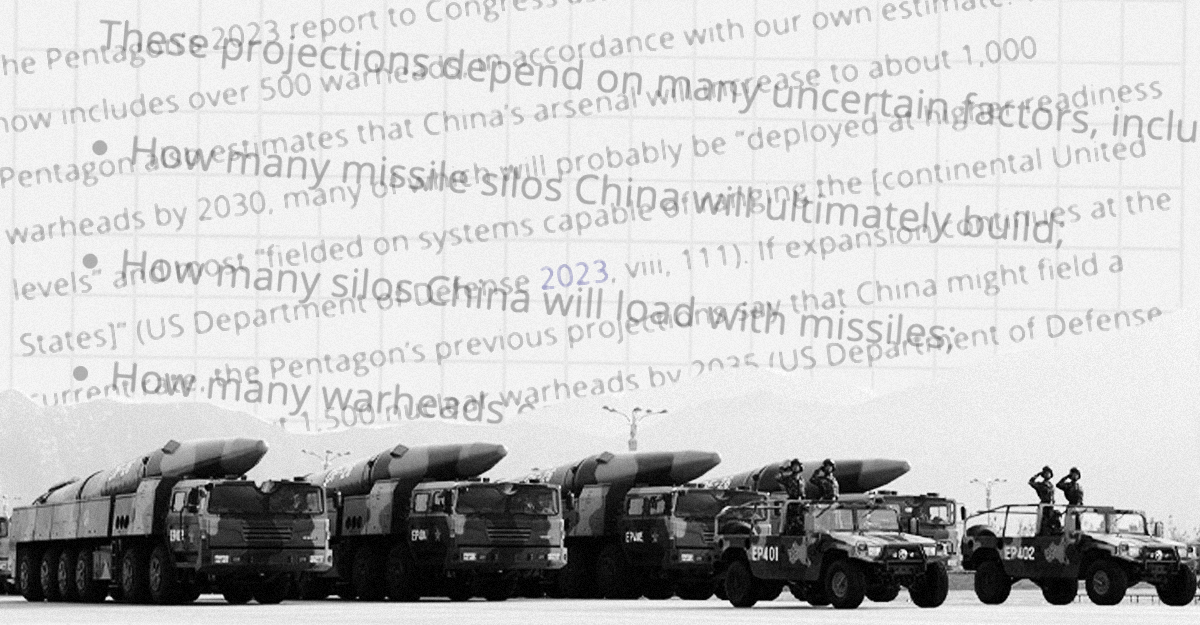
Chinese Nuclear Forces, 2024: A “Significant Expansion”
The Federation of American Scientists’ Nuclear Information Project, a component of the Federation’s Global Risk program, today released its latest assessment of China’s growing nuclear arsenal: the 2024 Nuclear Notebook on Chinese Nuclear Forces. The 24-page report, published in the Bulletin of Atomic Scientists, includes details on China’s nuclear weapons arsenal, including types of weapons, delivery vehicles, operations, and, importantly, questions that can help determine the reliability and accuracy of projections about the future growth of China’s nuclear capabilities.
The Notebook comes at a critical time for U.S. analysis and policy debates regarding China’s nuclear forces and the appropriate U.S. and allied response. In October 2023, the Pentagon released its annual report to Congress on Military and Security Developments Involving the People’s Republic of China. This report preceded the release of both the Strategic Posture Commission report and the State Department’s International Security Advisory Board report on Nuclear Deterrence in a World of Nuclear Multipolarity. Within the U.S. government, military, and national security community, analysts are evaluating the implications of China’s growing nuclear force for nuclear deterrence, global stability, and U.S. security commitments in East Asia, Europe, and beyond.
What about the DOD’s numbers?
Meanwhile, the 2024 Nuclear Notebook on Chinese nuclear forces comes on the heels of a news report from Bloomberg that suggest corruption in China’s military procurement program may have resulted in the production or delivery of nuclear-tipped missiles and missile silos that do not operate properly. Reports about China’s corruption are not new, but the potential impact on the unprecedentedly rapid projected growth of China’s nuclear forces has not been previously reported, nor has it been reflected in reports, testimony, or statements by top Administration, defense, or intelligence officials.
Given the potential implications of the Bloomberg report, FAS sent a letter to Secretary of Defense Lloyd Austin asking whether the reported intelligence about the reliability of China’s missile force was known to the authors of DOD reports on China’s nuclear program and, if so, why they were not reflected in reports sent to Congress. As one of the most authoritative non-governmental sources on global nuclear forces, FAS has a unique interest in ensuring that its reports are objective and reflect the full extent of government and non-governmental expert understanding of nuclear arsenals worldwide.
2024 Nuclear Notebook: Key findings on China’s nuclear forces
Analyzing and estimating China’s nuclear forces is challenging, particularly given the relative lack of state-originating data and the tight control of messaging surrounding the country’s nuclear arsenal and doctrine. Like most other nuclear-armed states, China has never publicly disclosed the size of its nuclear arsenal or much of the infrastructure that supports it. The analyses and estimates made in the Nuclear Notebook are derived from a combination of open sources, including (1) state-originating data (e.g. government statements, declassified documents, budgetary information, military parades, and treaty disclosure data), (2) non-state-originating data (e.g. media reports, think tank analyses, and industry publications), and (3) commercial satellite imagery. From this information, FAS has tracked the significant expansion of China’s ongoing nuclear modernization program. Key findings from the 2024 FAS assessment on Chinese nuclear forces include:
- China’s nuclear expansion is among the largest and most rapid modernization campaigns of the nine nuclear-armed states.
- FAS estimates that China has produced a stockpile of approximately 500 nuclear warheads, with 440 warheads available for delivery by land-based ballistic missiles, sea-based ballistic missiles, and bombers.
- The latest Pentagon projection appears to apply the same growth rate of new warheads added to the stockpile between 2019 and 2021 to the subsequent years until 2035. FAS assesses that this projected growth trajectory is feasible but depends significantly upon many uncertain factors and assumptions.
- China has continued to develop its three new missile silo fields for solid-fuel intercontinental ballistic missiles (ICBMs), expand the construction of new silos for its liquid-fuel DF-5 ICBMs, and has been developing new variants of ICBMs and advanced strategic delivery systems.
- China has further expanded its dual-capable DF-26 intermediate-range ballistic missile (IRBM) force, which appears to have completely replaced the medium-range DF-21 in the nuclear role.
- China has been refitting its Type 094 ballistic missile submarines with the longer-range JL-3 submarine-launched ballistic missile (SLBM).
- China has recently reassigned an operational nuclear mission to its bombers and is developing an air-launched ballistic missile (ALBM) that might have nuclear capability.
This research was carried out with generous contributions from the New-Land Foundation, Ploughshares Fund, the Prospect Hill Foundation, Longview Philanthropy, and individual donors.
While it is reasonable for governments to keep the most sensitive aspects of nuclear policies secret, the rights of their citizens to have access to general knowledge about these issues is equally valid so they may know about the consequences to themselves and their country.
Nearly one year after the Pentagon certified the Sentinel intercontinental ballistic missile program to continue after it incurred critical cost and schedule overruns, the new nuclear missile could once again be in trouble.
“The era of reductions in the number of nuclear weapons in the world, which had lasted since the end of the cold war, is coming to an end”
Without information, without factual information, you can’t act. You can’t relate to the world you live in. And so it’s super important for us to be able to monitor what’s happening around the world, analyze the material, and translate it into something that different audiences can understand.